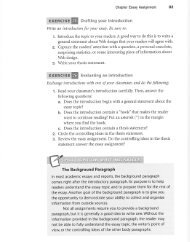College Writing 3-1
Create successful ePaper yourself
Turn your PDF publications into a flip-book with our unique Google optimized e-Paper software.
Chapter Essay Assignment 61<br />
Web Evaluation Criteria<br />
CARP This evaluation concept was developed by Robin Williams<br />
-<br />
and John Tollett and is amajor component in their book,The Non-<br />
Designer'sWeb Book.<br />
(C) Contrasf is what draws your eyes into a page. The contrast might<br />
be type that is bolder, bigger, or a very different style. It might be<br />
different colors, graphic signposts, or a spatial arrangement. To<br />
be effective, contrast must be strong. A key component when<br />
evaluating contrast is to determine the focal point or main<br />
dominating feature of the page.<br />
(A) Alignment simply means that the items on the page are lined up<br />
with each other. Some pages align to the left, others to the<br />
right, and still more are centered on the page. Beware of sites<br />
that mix alignments throughout their pages.<br />
(R) Repetition refers to the repeated elements that uni$r the website.<br />
Each page in a website should look like it belongs to the same<br />
website and portrays the same concepts. Repetition is what<br />
makes this happen.<br />
(P) Proximity refers to the relationships that objects develop when<br />
they are close together, in close proximity. When objects are<br />
placed close together, they appear to have a relationship, and the<br />
opposite is also true. \\4ten two items are separated by space,<br />
they appear to have no relationship to each other.<br />
Another concept that is very useful when evaluating websites is the<br />
TILI concept, developed by Ieff Peach.<br />
(T) Text refers to the size, color, font, and font style, which are all<br />
contributing factors of Web design. The majority of information<br />
on most webpages is still delivered through text. The qualities of<br />
the text are an important component to the website.<br />
(l) Images are essential to our visually oriented society. More and<br />
more websites are incorporating pictures and images. The<br />
placement, size, format, and resolution of the images are<br />
important components in website design.<br />
(L) Links, or more specifically hlperlinks, can be located anpvhere<br />
on a webpage. A picture, image, or string of text can be set to<br />
be a hyperlink. Hlperlinks tell the Web browser to connect to<br />
another site or folder and either display another webpage or<br />
download a file. Links are what allows users to navigate a website.<br />
(T) Tables allow web designers to organize and group information'<br />
The use of tables has also developed into a tool that plays a<br />
major factor in page design.




